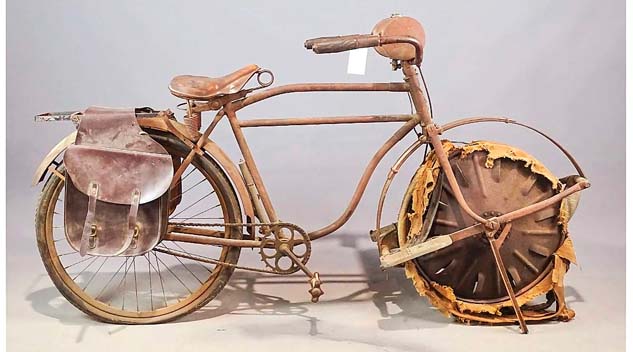#Copake #Continues #Market #Antique #Vintage #Bicycles #Antiques #Arts #Weekly
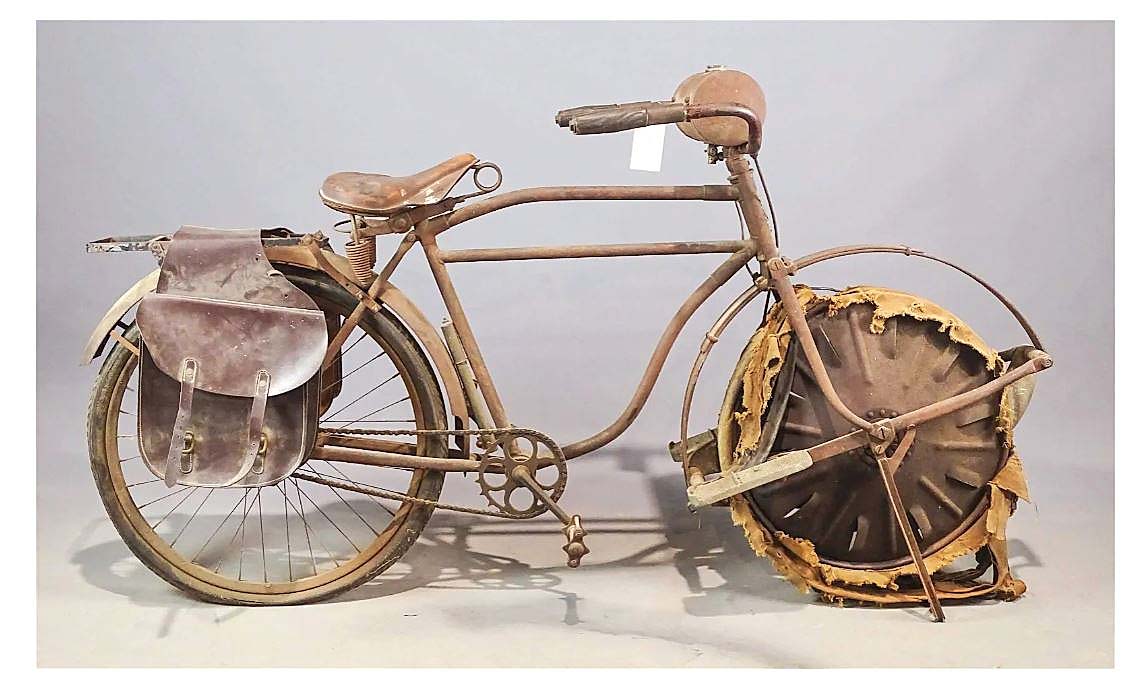
This 1915 Dayton Motorbike in “as-found” condition was the top lot in the sale, zooming from an $800-$1,200 estimate to sell for $24,000, when two phone bidders duked it out — with one in the Midwest, the other an unidentified television celebrity, who prevailed. “People like Daytons — a lot,” observed Mike Fallon. “It’s a very rare bike.”
Review by W.A. Demers; Photos Courtesy Copake Auction
COPAKE, N.Y. — “Before tossing one, hard-earned Simoleon of yours at this Wright-Brothers/Davis contraption…” warns a cycling forum contributor at www.thecabe.com. His subject: the 1915 Dayton Motorbike, an “as-found” example of which was the top lot in Copake’s March 29 auction. The motorbike zoomed from an $800-$1,200 estimate to sell for $24,000. Co-owner Mike Fallon said there were five people on the phone vying for it, then it was winnowed down to three; finally, there were two phone bidders duking it out, with one in the Midwest, the other an unidentified television celebrity, who prevailed. “People like Daytons — a lot,” observed Fallon. It’s a very rare bike.” Catalog notes said simply, “sold as found with no title.”
More information on the motorized-bicycle can be found at the Dayton History website — www.daytonhistory.org. “With the advent of the automobile, the bicycle’s popularity began to decline. Innovations in combustible engine manufacturing meant that…engines could be used just about anywhere, including on a two-wheeled bicycle. Inventors in Europe had been experimenting with early motorcycles since the 1880s, and in 1901, America’s first motorcycle company, the Indian Motorcycle Manufacturing Company, was founded. Dayton’s Davis Sewing Machine Company had been a leading manufacturer in bicycles for more than two decades when they introduced and patented the Dayton Motorwheel in 1915. This motorbike combined a light-weight frame with both foot pedals and a small engine, manufactured by the American Magneto Company. The cycle could be ridden either as a regular bicycle or as a motorcycle.”

A large lot of handlebars and stems, including names like Superbe, Cinelli, Ambrosio, Gitam, Douglas, Pearl, Philippe, Sunshine, Atala and others, exceeded its $50/75 valuation to finish at $3,360.
The overall sale was “highly successful,” according to Mike Fallon. It was staged in an adjacent warehouse with the bikes, parts and accessories set up and laid out on tables. Following the preview, auction patrons repaired to the gallery where each lot was shown on a big television screen for bid-taking. Seth Fallon, Mike’s son, said the sale total was $156,000 with only three items out of the 300 lots not selling. There were 3,000 absentee bids logged and more than 1,000 registered bidders.
The theme for the sale was transportation & music and it featured antique, vintage and modern bicycles and parts, a collection of motorcycles, musical instruments, including guitars, amps, studio items and more. The firm’s big and highly anticipated bicycle sale is typically conducted in the fall in conjunction with a group ride and bike swap, but this collection came good-to-go by itself to settle an estate. When asked if he thought the Dayton might have gotten a higher price if held back for the fall sale, Mike Fallon gave an emphatic, “No, the people we expected to be there, were there.”
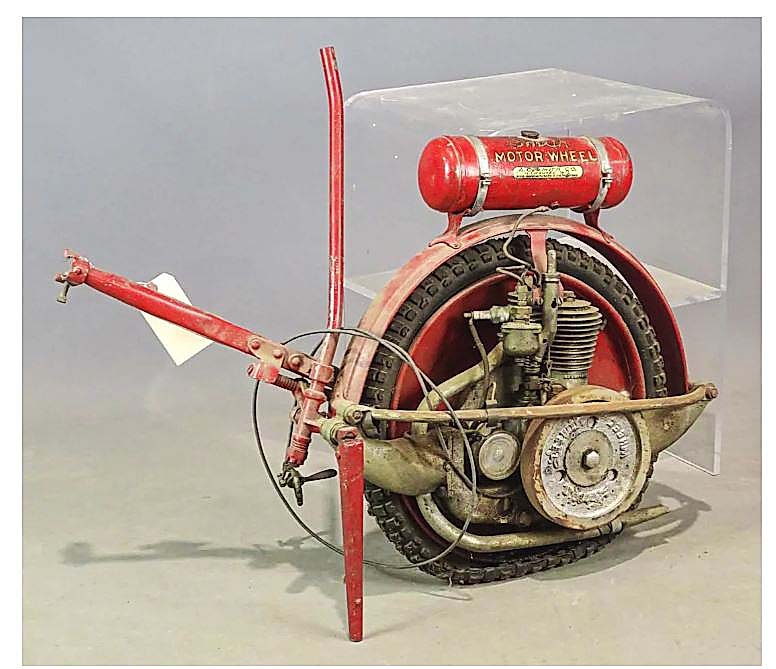
An early Smith Motor Wheel, 36 inches long, motored to $4,800, ignoring a $400/600 expectation. Invented in 1910 by an Englishman named Wall for bicycle propulsion, its US manufacturing rights were bought by the A.O. Smith Company, which marketed the first Smith Motor Wheel in October 1914.
Also ignoring a low estimate, in this case a $400/600 expectation, an early Smith Motor Wheel, 36 inches long, motored to $4,800. What is a “motor wheel,” you might ask? If the cataloging was brief, a British reference website — The Moped Archive — gave more insights. In 1910, according to the writeup, a young man in England by the name of Wall invented the Motor Wheel for bicycle propulsion. It was called the Wall Auto Wheel.
“This machine had a wire-spoked wheel, which was driven by a chain from the 1 HP engine,” according to the site. “The Auto Wheel used a two-lobe camshaft, geared 4-to-1, with an air-cooled cylinder.”
In Milwaukee, Wis., the A.O. Smith Company bought the US manufacturing rights from Wall, made a few changes in the construction of the Auto Wheel (changing it from a wire wheel to a disc wheel, which allowed it to do away with the chains.) In October 1914, the first Smith Motor Wheel was put on the market. The 1914 and 1915 Smith Motor Wheels were known as the Model A. They were identical with one exception: the flywheel on the 1914 was plain, while the 1915 flywheel had “Smith Motor Wheel” in raised letters.
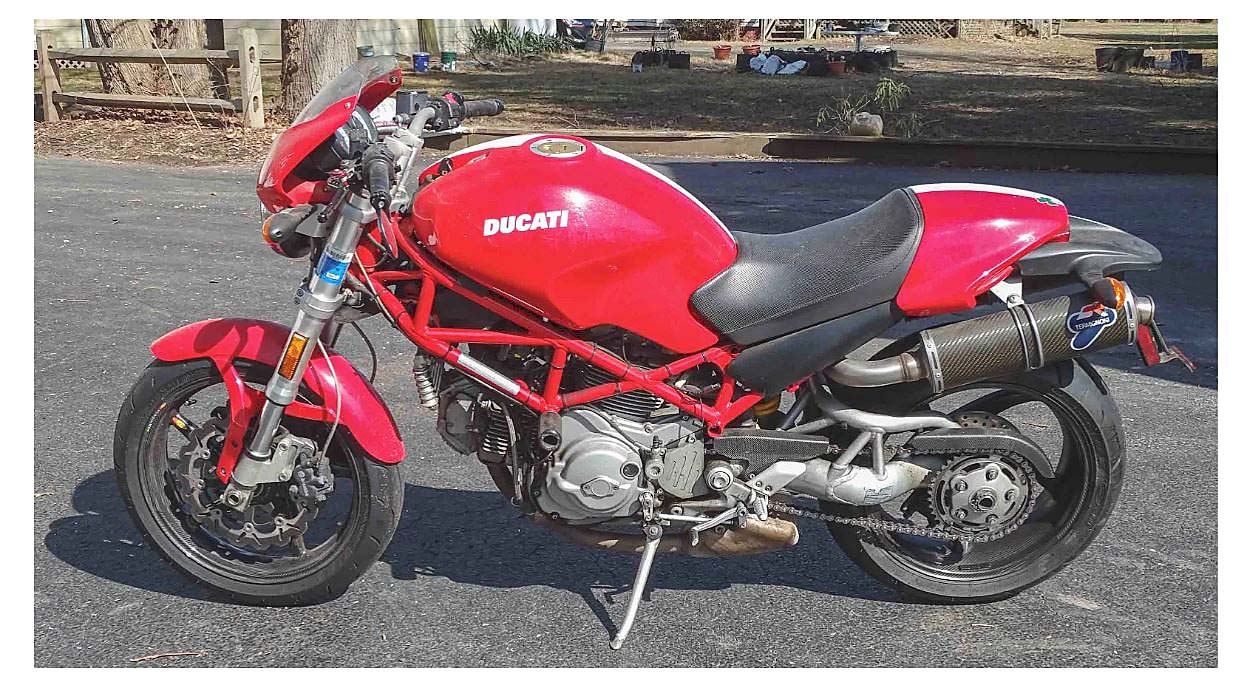
A Ducati Monster S2R motorcycle, 800cc, with 8,627 original miles from one owner, sold for an above-estimate $4,500. It came with a New York State title, a complete maintenance history and a host of accessories.
Fast forward to 2005. Selling for an above-estimate $4,500 was a Ducati Monster S2R motorcycle, 800cc, with 8,627 original miles. The one-owner motorcycle came with a New York State title, a complete maintenance history and a host of accessories. The sleek ride was Mike Fallon’s, himself a motorcycle collector.
Even propulsion had its fans. One bidder loved a circa 1918 Harley Davidson motor so much, they ignored its $200/300 estimate and shelled out $3,900 Simoleons for it.
And it may have seemed like Christmas to another bidder, whose love for obtaining a large lot of handlebars and stems, including names like Superbe, Cinelli, Ambrosio, Gitam, Douglas, Pearl, Philippe, Sunshine, Atala and others, resulted in the lot exceeding its $50/75 valuation to finish at $3,360.
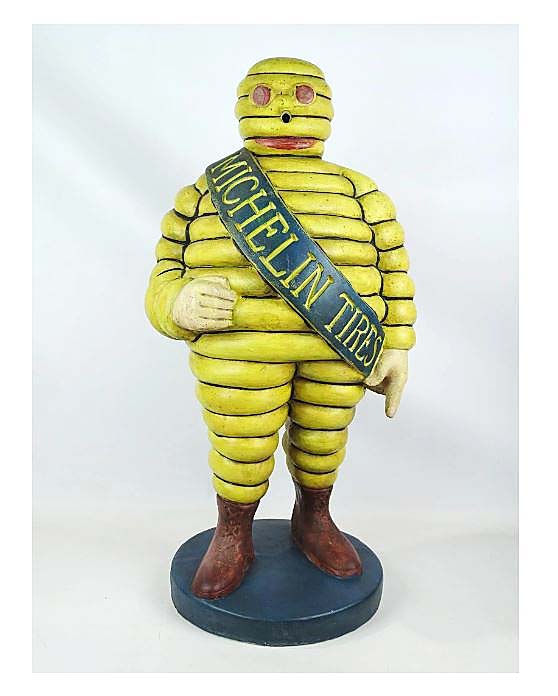
The official mascot of the Michelin tire company, a vintage Michelin Tire Bibendum statue, 32 inches high, which had been repainted, brought $3,340, more than double its high estimate.
Fetching $3,240, more than double the high estimate, was a vintage Michelin Tire Bibendum statue, 32 inches high, which had been repainted. The bulbous character’s name comes from the Latin “Nunc est Bibendum,” which translates as “now is the time to drink!” Consisting of stacked white tires, he became the official mascot of the Michelin tire company, introduced at the Lyon Exhibition of 1894 where the Michelin brothers had a stand.
In the realm of musical instruments, a local consignment yielded a Fender Telecaster guitar that was estimated $300/400 but did much better, leaving the gallery at $3,900. Pale yellow, the desirable instrument came with a case. From the same consignment, a Gibson Custom Shop guitar in cherry red also improved on its valuation, selling for $3,480 against a $400/600 estimate.
Prices given include the buyer’s premium as stated by the auction house. The firm’s next auction is May 17-18, the first day dedicated to garden antiques and furnishings. For further information, 518-641-1935 or www.copakeauction.com.

